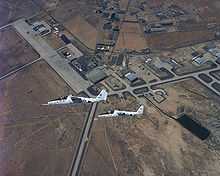Fairchild T-46
The Fairchild T-46 (nicknamed the "Eaglet") was an American light jet trainer aircraft of the 1980s. It was cancelled in 1986 with only three aircraft being produced.
Design and development
The United States Air Force (USAF) launched its Next Generation Trainer (NGT) program to replace the Cessna T-37 Tweet primary trainer in 1981.[1] Fairchild-Republic submitted a shoulder-winged monoplane with a twin-tail, powered by two Garrett F109 turbofans and with pilot and instructor sitting side-by-side.[2]
In order to validate the proposed aircraft's design, and to explore its flight handling characteristics, Fairchild Republic contracted with Ames Industries of Bohemia, New York to build a flyable 62% scale version. Burt Rutan's Rutan Aircraft Factory (RAF) in Mojave, California was contracted to perform the flight test evaluations, with test pilot Dick Rutan doing the flying. The scale version was known at RAF as the Model 73 NGT, this flying on 10 September 1981.[3]
Fairchild's design, to be designated T-46, was announced winner of the NGT competition on July 2, 1982,[2] with the USAF placing an order for two prototypes and options for 54 production aircraft.[4]
The aircraft first flew on October 15, 1985,[5] but was cancelled a little more than a year later, for reasons that largely remain controversial.[citation needed] The T-46 was the last project of the Fairchild Republic Corporation, and after the program termination Fairchild had no more income. Without any new contracts and the NGT program cancelled, the company closed the Republic factory in Farmingdale, New York, bringing 60 years of Fairchild aircraft manufacturing to an end.

The aircraft itself featured a side by side configuration, a twin (or "H") tail (similar to the company's A-10), ejection seats, pressurization, and two turbofan engines. Had it gone into full production the NGT program called for 650 aircraft being built up to 1992. There was potential for some overseas sales as well, such as in the light ground attack role in addition to its role as a trainer.[6]
Operators
Aircraft on display
All three prototypes have been preserved:
- 84-0492 can be seen at the Air Force Flight Test Center Museum at Edwards Air Force Base, California.
- 84-0493 is under restoration at the National Museum of the United States Air Force.[7]
- 85-1596 can be seen at the AMARG "Celebrity Row" during the AMARG bus tour from the Pima Air Museum, Arizona
- The Model 73 NGT Flight Demonstrator can be seen at the Cradle of Aviation Museum, New York
Specifications (T-46) (performance estimated)

Data from Tweety-Bird Replacement[8]
General characteristics
- Crew: two; trainer, student
- Length: 29 ft 6 in (8.99 m)
- Wingspan: 38 ft 7¾ in (11.78 m)
- Height: 9 ft 11¾ in (3.04 m)
- Wing area: 160.9 ft² (14.95 m²)
- Aspect ratio: 9.28
- Empty weight: 5,275 lb (2,393 kg)
- Max. takeoff weight: 6,962 lb (3,158 kg)
- Powerplant: 2 × Garrett F109-GA-100 turbofan engines, 1,330 lbf (5.93 kN) each
- Internal fuel capacity: 200 US Gal (757 L)
Performance
- Maximum speed: 397 knots (457 mph, 735 km/h) at 25,000 ft (7,600 m)
- Cruise speed: 333 knots (383 mph, 616 km/h) at 45,000 ft (13,700 m)
- Range: 1,190 nm (1,369 mi, 2,205 km)
- Service ceiling: 46,500 ft (14,175 m)
- Rate of climb: 4,470 ft/min (22.7 m/s)
- Take-off distance: 1,520 ft (463 m) (to 50 ft (15 m))
See also
- Aircraft of comparable role, configuration and era
- T-37 Tweet
- T-6 Texan II
References
- ↑ Braybrook 1985, p. 274.
- ↑ 2.0 2.1 Braybrook 1985, p. 275.
- ↑ Braybrook 1985, pp. 275–276.
- ↑ Flight International 17 July 1982, p. 122.
- ↑ Flight International 26 October 1985, p. 8.
- ↑ Warwick 1985, p. 29.
- ↑ Fact Sheet: FAIRCHILD REPUBLIC T-46A". National Museum of the USAF. Retrieved 15 May 2011.
- ↑ Braybrook 1985, p. 276.
- Braybrook, Roy. "Tweety-Bird Replacement". Air International, June 1985, Vol 28, No. 6. pp. 273–280.
- "Fairchild wins NGT". Flight International, 17 July 1982, p. 122.
- "T-46A is flown". Flight International 26 October 1985, p. 8.
- Warwick, Graham "T-46: A Class Apart". Flight International, 13 April 1985, pp. 24–29.
External links
| Wikimedia Commons has media related to Fairchild T-46. |
| |||||||||||||||||||||||||||||
| ||||||||||||||||||||||||||
| ||||||||||||||